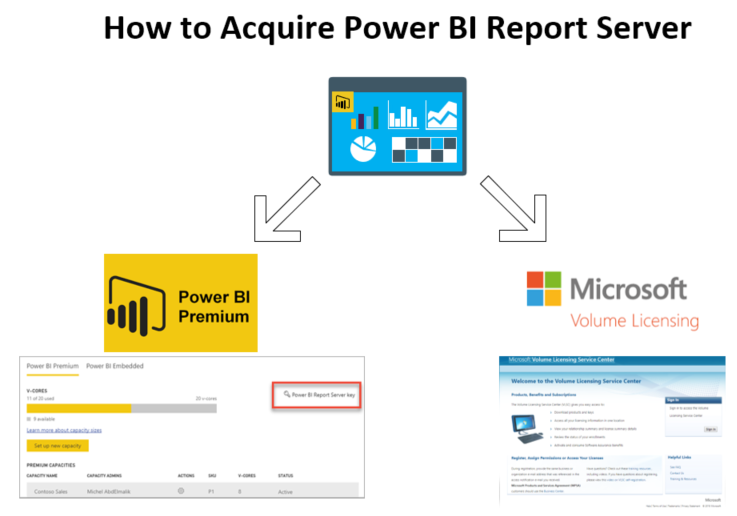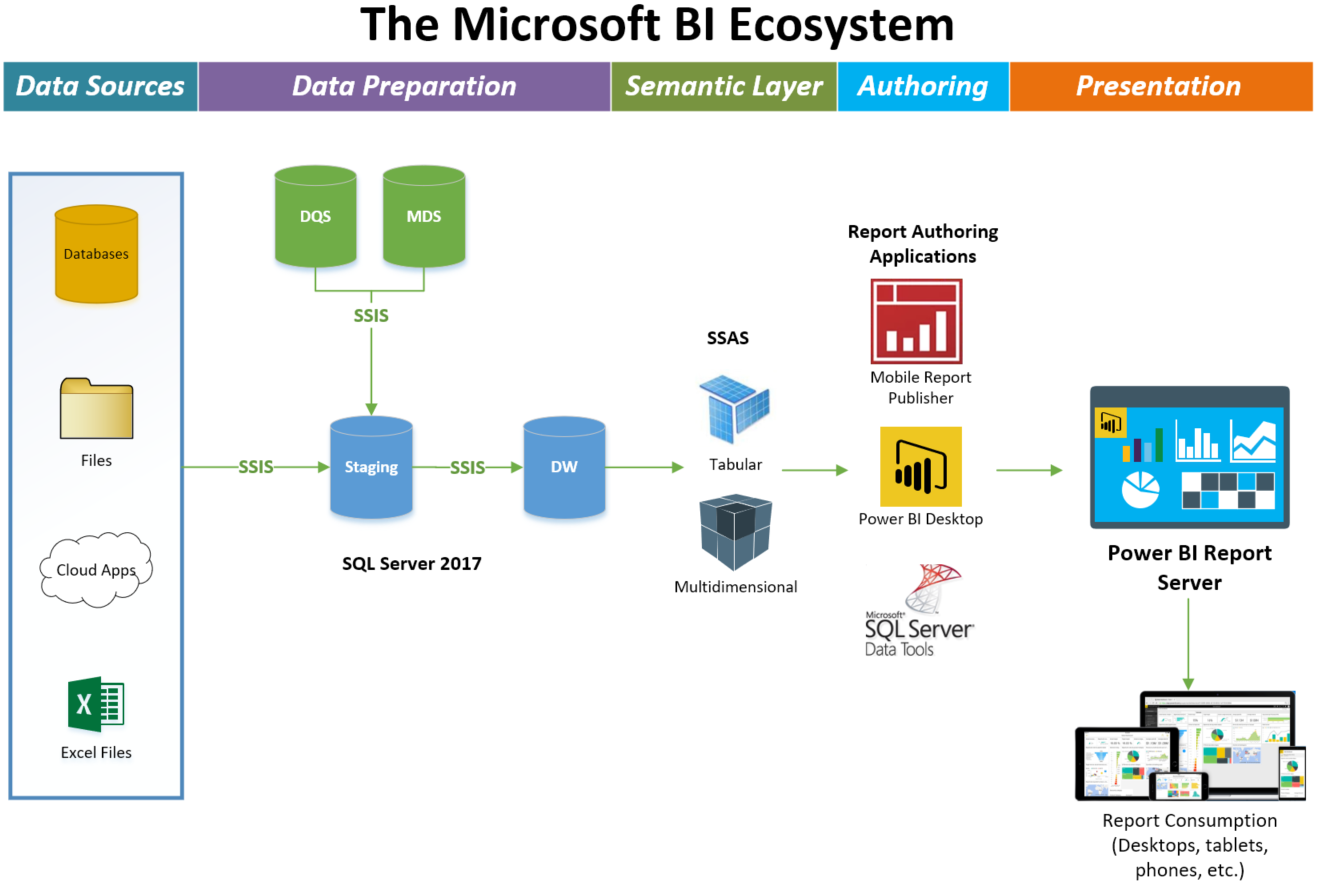A modern on-premises BI solution
This blog post serves as the first in a series on the topic of Power BI Report Server, an underrated addition to the overall Power BI product family. Last year, we wrote a blog post that introduced the Power BI Report Server. The post was well-received and made it evident that people are looking to learn more about the product.
Our goal is to provide further education on the product by focusing on topics such as:
- Purchasing Power BI Report Server
- How Power BI Report Server modernizes your on-premises BI solution
- Hybrid Power BI implementation scenarios (Service & Report Server)
- Power BI DevOps strategies & tips
- “War stories” from an actual large-scale Power BI Report Server implementation
POWER BI REPORT SERVER RECAP
Even with our introduction to Power BI Report Server blog post, we still received quite a few questions about what Power BI Report Server even is. Our aim with this recap is to put those questions to bed by illustrating key points.
WHAT IS POWER BI REPORT SERVER?

Power BI Report Server is an on-premises product based on the SQL Server Reporting Services (SSRS) framework which allows hosting, sharing, and collaborating on Power BI Reports, all behind your organization’s firewall. The key words in that previous sentence are “on-premises”, “SSRS framework” and “Power BI Reports”. Let’s take a closer look at each of those.
ON-PREMISES
Unlike the Power BI Service, which is a cloud-based analytics platform hosted by Microsoft, or Power BI Premium, which is simply dedicated cloud capacity within the Power BI Service, Power BI Report Server is a product that is installed and configured on a dedicated on-premises server.

SSRS FRAMEWORK
As illustrated above, Power BI Report Server is also built atop the SSRS framework, thus allowing you to deploy SSRS reporting assets such as paginated reports, mobile reports, KPIs, and Excel workbooks to your Power BI Report Server. Additionally, this means you can easily migrate an existing SSRS implementation to Power BI Report Server.
POWER BI REPORTS
In terms of Power BI assets, only Power BI Reports can be deployed to the Power BI Report Server. Power BI assets and functionality such as Dashboards and Q&A are only available in the Power BI Service.

YEAH, THAT’S GREAT, BUT HOW DO WE PURCHASE POWER BI REPORT SERVER?
Unfortunately, Power BI Report Server cannot be purchased directly as a standalone product. There are currently only two ways to acquire Power BI Report Server. The Microsoft preferred way is via purchasing Power BI Premium capacity within the Power BI Service. This will give you the ability to install and configure an on-premises Power BI Report Server to compliment your cloud premium capacity. Acquiring Power BI Report Server via this method sets that stage for a hybrid Power BI implementation, which is a topic we will discuss further in a subsequent blog post.
WE HAVE NO INTEREST IN THE CLOUD. WHAT’S THE OTHER WAY TO ACQUIRE POWER BI REPORT SERVER?
The other way to acquire Power BI Report Server is by purchasing SQL Server Enterprise edition with active Software Assurance (SA). If you already have SQL Server Enterprise and active SA, you can obtain your license key from the Microsoft Volume Licensing Service Center (VLSC).
For more information on SQL Server licensing or Software Assurance benefits, check out Microsoft’s SQL Server licensing guide and datasheet.
NOTE: An important purchasing footnote is that although it is an on-premises report server, you must still purchase Power BI Pro licenses for any report authors that will be publishing Power BI reports to your production server(s). Therefore, if you have ten report authors, but only two individuals handle publishing to Production, then only two Power BI Pro licenses are required. This is an honor-based system from an enforcement standpoint.


| Power BI Report Server is included as part of your purchase of Power BI Premium capacity within the Power BI Service. You may think of it as an “add on” to purchasing Premium capacity. Obtaining Power BI Report Server via this method is optimal for those organizations that are looking for a hybrid (both cloud and on-premises) BI architecture. | Power BI Report Server is included as part of your purchase of SQL Server Enterprise with active Software Assurance (SA). This is currently the ONLY way on-premises customers can obtain Power BI Report Server. Consider this another perk if you choose to purchase SQL Server Enterprise edition over Standard edition. |
A MODERN ON-PREMISES BI SOLUTION
Figure 6 – The remainder of this post will focus on acquiring Power BI Report Server via SQL Server Enterprise with active SA.
The remainder of this post will focus on organizations that:
- Want, or need, their BI solution 100% on-premises
- May have an existing investment in Microsoft BI products such as SSRS, Mobile Reports, and PerformancePoint, but want to see how Power BI fits in
- May have an existing investment in other vendor BI products such as MicroStrategy, OBIEE, BusinessObjects, Tableau, Qlik, etc., but leverage the SQL Server suite in their back-end architecture
- Don’t currently have any investment in Microsoft data and analytics, but are “kicking the tires”
POWER BI COMPLEMENTS SSRS
SSRS is a mature BI product that has been in use for well over a decade now. However, the main gripes against SSRS are that:
- It’s more static than interactive
- Report development is not drag-and-drop, therefore development time can be lengthy
- Report development typically involves an understanding of various querying languages such as SQL, DAX, and MDX
- Report development is typically the responsibility of IT and not consumers of the report
NOTE: We have yet to see an organization use Report Builder to enable their power users to build their own paginated reports.
The beauty of Power BI is that it serves as the answer to all those SSRS gripes, and much more. Power BI reports are highly interactive by default. For example, you can have visuals cross-filter one another by simply clicking on a data point. Power BI Desktop provides an intuitive drag-and-drop interface. Power BI report development can fall to the hands of report consumers. This can free up IT resources to build and maintain corporate BI data sources such as SSAS tabular models or multidimensional cubes.
We have had numerous customers ask: “Which product should we use then? SSRS or Power BI?”
Our response is always, “Why not both?”
If you own Power BI Report Server, why not leverage both? In general, SSRS is a great product to use when you want to produce “show me the numbers” reports. Power BI is a great product to produce highly visual reports to help you spot trends, anomalies, and provide “ah-ha!” moments that are hard to achieve by looking at a table full of numbers.
GENERALLY, WHEN TO USE EACH PRODUCT
| SSRS | Power BI |
|
You hear the requirement: |
You hear the requirement: |
POWER BI COMPLIMENTS THE SQL SERVER SUITE
The on-premises SQL Server suite provides an end-to-end solution for all your organization’s BI needs. The SQL Server suite provides a mature set of technologies that cover areas from ETL, MDM, data quality, data warehousing, semantic modeling, and reporting. Power BI Report Server is the cherry on top of it all. What had always been lacking in the on-premises suite was a product that could allow organizations to quickly and easily visualize their data.
Lastly, if you’re already leveraging SQL Server components as part of your back-end infrastructure, but use a different vendor product for reporting, Power BI Report Server serves an inexpensive alternative. We’ve worked with customers that had all Microsoft back-end components (SQL Server, SSIS, SSAS, MDS), but used products from vendors such as MicroStrategy, Tableau, and Qlik for their presentation needs. Often, their reasoning for not using Microsoft for their reporting needs was due to a lack of a self-service visualization product. With the introduction of Power BI Report Server, organizations may want to revisit their investments in other BI vendors and see what Power BI has to offer.

Have questions about Power BI Report Server or just want to learn more? Contact us! We would be happy to share more examples of how you can also take advantage of this great technology.






